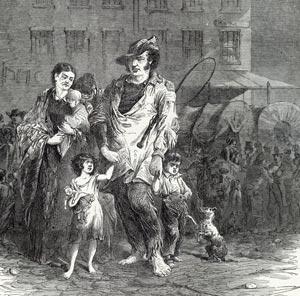The Civil War in Missouri
Save ThisMy CollectionGeneral Sterling Price

Highlights
- Sterling Price was born on September 11, 1809, in Prince Edward County, Virginia. He came to Missouri in 1831 and began farming in the Boone’s Lick salt spring area, between Fayette and Keytesville, along with many other former Virginians.
- He ventured into politics in 1838 after being elected to the state legislature and became speaker of the house by 1840.
- This whirlwind rise in prominence helped him promote his belief in Southern values—chief among them the issue of states’ rights.
In-Depth
Sterling Price was born on September 11, 1809, in Prince Edward County, Virginia. He came to Missouri in 1831 and began farming in the Boone’s Lick salt spring area, between Fayette and Keytesville, along with many other former Virginians. In 1833, he married Martha Head and immediately began having children. He would eventually have 5 who would live to adulthood. Before long he expanded his business ventures to include a general store and real estate speculation. He joined the local militia and was elected colonel. He ventured into politics after being elected to the state legislature in 1838 and became speaker of the house by 1840. This whirlwind rise in prominence helped him promote his belief in Southern values—chief among them the issue of states’ rights.
Politics and War
Highlights
- In 1846, Price received an appointment from Missouri senator Thomas Hart Benton to lead the 2nd Missouri Volunteers in the Mexican-American War. When Price returned he was a war hero. His fame propelled him to the office of governor from 1853 to 1857.
- By 1860, Price had come to view slavery as an evil. However, he chose to side with the Confederacy when the Civil War broke out because he feared the Federal government’s use of force in Missouri.
- After the events of Camp Jackson on May 10, 1861, Price organized the Missouri State Guard to try to stop the federal troops who intended to drive the secessionist Missouri government from power.
- He would lead the Missouri State Guard against Federal forces under General Nathaniel Lyon.
- After defeating the Federal army at Wilson’s Creek in August 1861, Price continued to occupy southwest Missouri until March 1862.
- Defeated at Pea Ridge, Arkansas, in March 1862, Price took his remaining army and officially joined the Confederate army. In 1864, Price led a raid into Missouri, which would be the last major military engagement inside the state through the end of the war.
In-Depth
In 1846, with the outbreak of the Mexican-American War, Price received an appointment from Missouri senator Thomas Hart Benton to lead the 2nd Missouri Volunteers. While serving in New Mexico, Price led his volunteers in suppressing a rebellion in Taos. This service earned him a promotion to brigadier general but involved extreme brutality. When he returned to Missouri he was a war hero, but the politics of Missouri had changed. The Democratic Party had split between those who supported his former benefactor Thomas Hart Benton and those who opposed him. When Price ran for governor he abandoned Benton. Price served as governor from 1853 to 1857. By 1860, when Price led the state convention to decide Missouri’s loyalties, he had come to view slavery as an evil. However, he chose to side with the Confederacy when the Civil War broke out because he feared the Federal government’s use of force in Missouri.
After the events of Camp Jackson on May 10, 1861, Governor Claiborne Fox Jackson and General Price met with the head of Federal troops, Nathaniel Lyon. This meeting, which took place at Planter’s House Hotel in St. Louis, did not end well, and it was clear that the Federal troops intended to drive Jackson and his government, which had proven to be secessionist, out of power. Price and Jackson fled St. Louis, burning bridges and cutting telegraph lines as they went. Price gathered the Missouri State Guard against the advancing Federal army of General Lyon. After defeating the Federal army at Wilson’s Creek in August 1861, Price continued to occupy southwest Missouri until March 1862. At that time, the superior Federal army of General Samuel Curtis drove Price south into Arkansas, defeating him and Confederate troops under General Benjamin McCulloch at the Battle of Pea Ridge.
Price took his remaining army and officially joined the Confederate army. He took a command under General P. G. T. Beauregard, fighting in Tennessee, Mississippi, and Virginia. In 1864, Price returned to Missouri with an invasion of troops designed to disrupt the state election and pull Union resources away from conflicts in the East. Following the major conflicts at Pilot Knob and Westport, Price and his army were repelled. Price’s 1864 raid was the last major military action inside Missouri during the war.
Later Life
Highlight
- After the Civil War ended, Price fled to Mexico, where he hoped to re-establish himself under the protection of Emperor Maximilian. Price returned to St. Louis in 1867, where he died on September 29 of the same year.
In-Depth
After the Civil War ended, Price fled to Mexico, where he hoped to re-establish himself under the protection of Emperor Maximilian, the French ruler who had taken control of that country. However, revolutionaries led by Benito Juarez overthrew Maximilian in 1867. Price returned to St. Louis, where many still viewed him as a hero, in 1867. He died in St. Louis that same year on September 29.
Vocabulary
Secessionist - a supporter of the withdrawal in 1860–1861 of 11 Southern states from the Union to form the Confederacy.
Primary Source

(Download 2.8 MB PDF)